I wanted to post another update from my garden and update from our Permaculture Meetup, which blogged about some time ago (Here’s our meetup group site: Oakland County Permaculture Meetup). Recently, I hosted what we call a “permablitz” or a work day where people come to help and learn. We have 10-15 permablitzes per year, and they are always a great way to meet people, learn, and help our community with various projects.
Resiliency and Community-Building through Permablitzes
Its an incredible thing, seeing people come together to work hard. I talked about this a bit with my barn raising post a while ago. We live in such an individualistic culture; the idea of community aid and community projects are still new to me, and to most of us, and thus they are always special. And truthfully, I can’t stress enough the importance of community in sustainability work. One person can build something small, but several people together seem to get much more than three individuals’ work done. We became a team, a tribe, a group of individuals working towards one goal. Its a powerful and magical thing.
There is another side to bringing people together to engage in good work–resiliency. Resiliency is a term used within permaculture design and, according to Peter Bane, refers to the degree that one “takes responsibility for one’s own household needs as part of a resilient local economy” (3). Permablitzes, community building, barn-raisings and the like can lead us to more resilient communities, where we are working together for common goals and becoming more responsible in providing for ourselves and our community. Those that came here didn’t just work–they learned something about fall garden bed prep, how to use tools, how to plant cover crops, how to sheet mulch, and so forth. They learned something about soil ecology and worked with others to enact change. The more we are able to come together and help each other, the more we are all able to learn, grow, and accomplish. This is the big picture of our meetup group, our sustainability work, and our permablitzes.
The Permablitz
We had 9 people out to work on the fall garden as well as remove some more of my lawn in the front and replace it with a “medicine wheel” bed. We started with harvesting beans and squash and beans from my main garden and cutting back sunflowers as more people arrived.
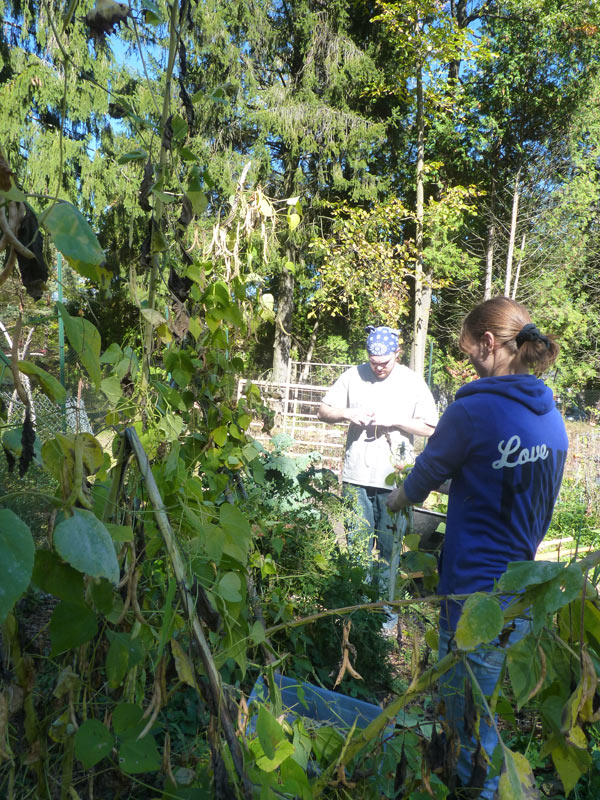
After that, we finished up out 3 of my 20′ x 4′ beds plus three of my friend’s 3′ x 15′ beds. With this work, we cut out old vegetable plants (keeping their root systems in the soil to not disturb the soil biology) and added all other parts of the plants to the compost pile. We weeded out grass and ground ivy, added finished compost to the beds, and finally, added cover crops of red clover or winter rye. Both cover crops help retain nutrients in the soil and prevent runoff (we have sandy soil, so this is a particular concern for the winter months and “empty” beds). The clover also adds nitrogen; the rye is a fabulous winter food for my chickens. The rye stays green all through the winter and provides them nutrients, even in January and February! Here are some photos of our work:

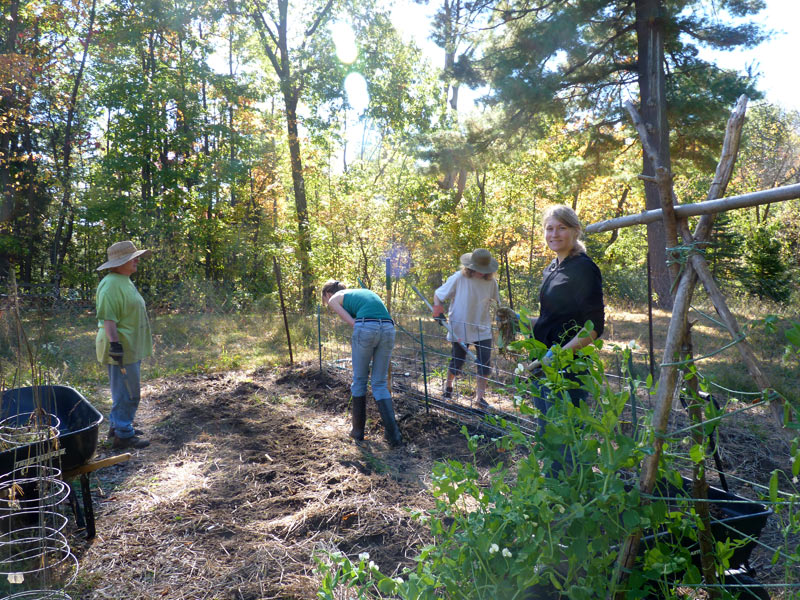
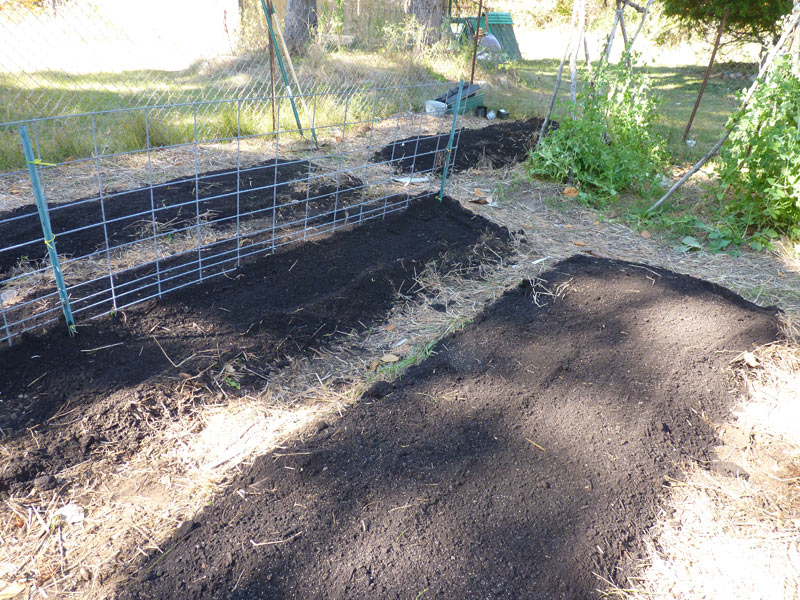
This was the conclusion of the “vegetable/annual” garden project. We decided also to tackle removing a bit more of my front yard and put in a “medicine wheel” inspired garden for perennials and herbs. To do this, we started by moving a bunch of wood to our fire pit (I had two dying spruce trees cut down last month that were in danger of falling on my house).
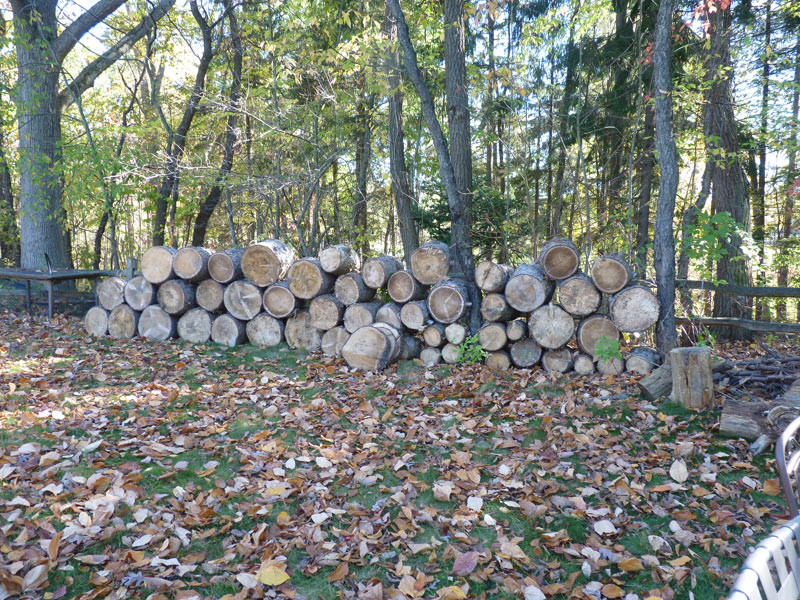
Then we began pulling out the grass, tilling, and building the bed. Looking back on it, we should have just sheet mulched it, but we went for it the hard way. Lesson learned, lol. Here we are in some of the final stages of the bed….
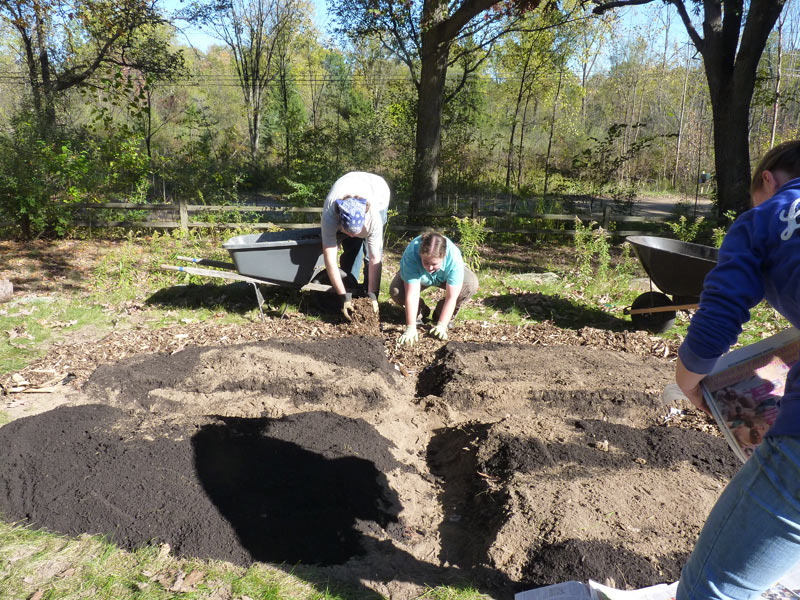
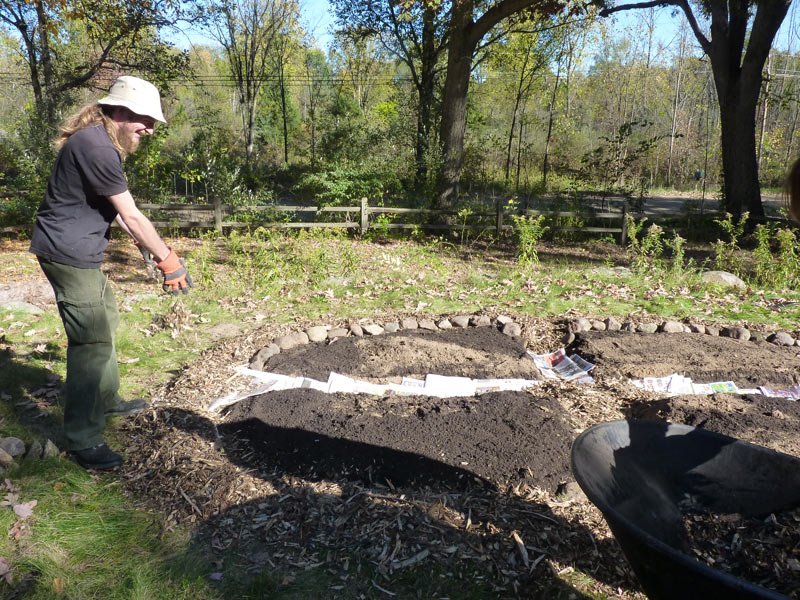
The process you see us doing here to establish the walkways is to put down a thick layer of newspaper or cardboard (at least 1/4″ thick to supress weeds) then add the wood mulch on top. The mulch comes from the trees I had cut down. The compost I purchased finished from a local company who recycles yard “waste”; all of the compost I made myself ended up in my garden and I was in need of more!
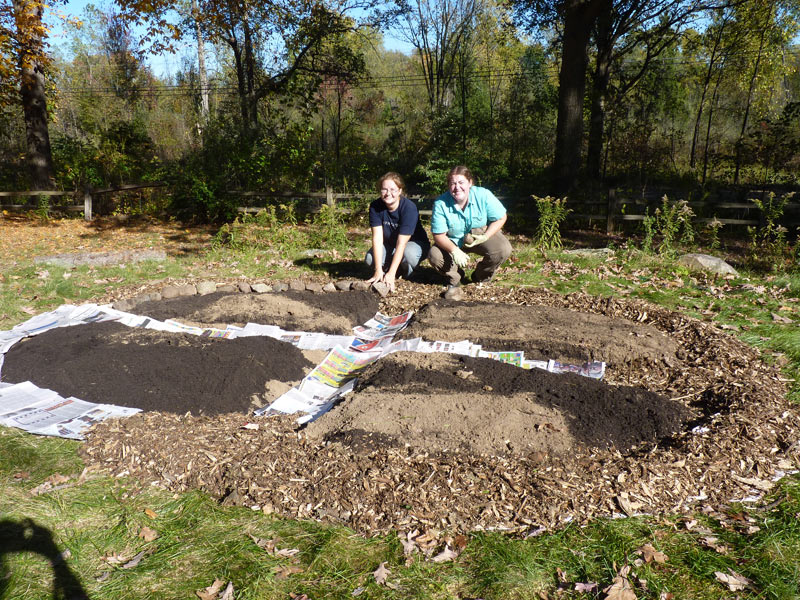
We gathered up the stones from the front of my property to make a stone edge around the beds. Here we are setting the last of the stones….

And…in a few short hours, another 50 or so feet of lawn gone and an amazing and sacred place for me to plant culinary, magical, or medicinal herbs. The weekend after this, a friend (who had been at the permablitz) came back and we expanded the bed using sheet mulching form a circular pathway around this central medicine wheel garden. I’m going to probably put a thick layer of leaves over these beds to help keep them from eroding or compacting too much in the winter months–then plant in the spring!
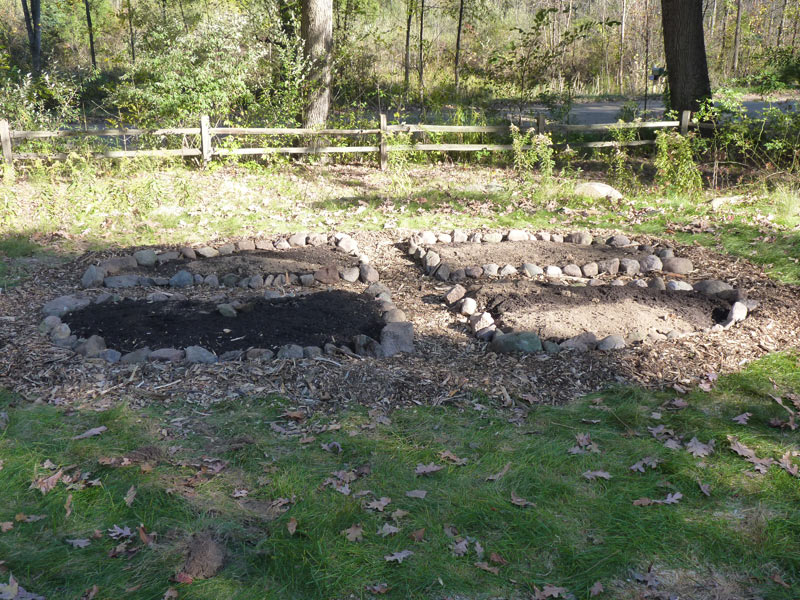
We also enjoyed each other’s company, and had a bunch of good food!
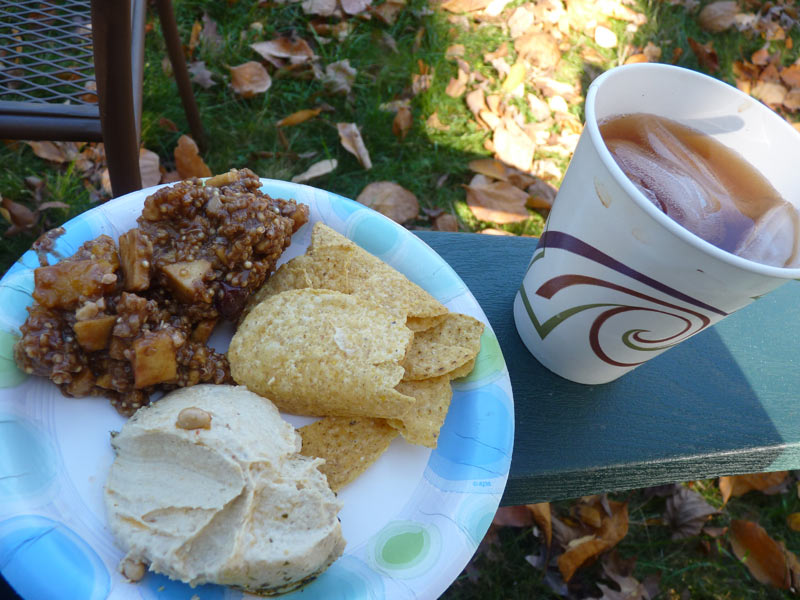
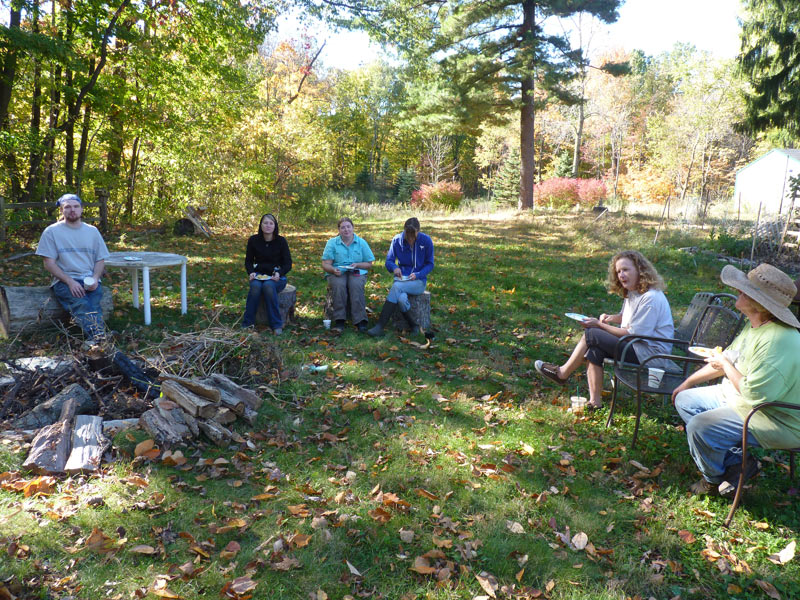
After the permablitz ended, four of us went on a fall leaf run (we got about 40 bags of leaves for my chickens and gardens) and another two of us went foraging for hickory nuts and pears. All and all, it was an incredible day and incredible experience, and I am so thankful to have everyone’s help. This work would have taken me probably till the middle or end of November…now I can work on some other projects and go to other permablitzes this month :).
For those of you who are feeling isolated or overwhelmed with what you want to accomplish–please remember that there are others out there looking to lend a helping hand. The amount that we can accomplish together, rather than divided, is amazing!



Can I just have a “like” button for this? 🙂 One question–when you put compost on your garden beds in the fall, do you work it in or just leave it on the surface?
There is a like button! But you have to have a wordpress account, I think :).
To answer your question–it depends on what you are doing with the bed. Bare beds in the winter leach a lot of nutrients and get compacted by snow and ice. If you are keeping the bed bare, I would absolutely work that compost into the soil and then top it with something to help prevent erosion like leaves or straw.
If you are going to plant a cover crop (next post about cover crops) then you can just add it to the top–the cover crop has to be turned over or tilled into the ground in the spring anyways, so it will all get mixed in then. I use red clover or winter rye for my cover crops :).
So I’d love to think out loud with you about “blitzing.” If 20 people come to my house and work for 4 hours, I feel like I owe them something more than my thanks and a pot of chili. Ideally, I would also help out on another blitz…or two…or 20. But there’s no way I have time to repay 80 hand-hours of work. In fact, it can be really hard to find just one weekend to give over to working on someone else’s yard – I’m doing all I can just to keep my garden in shape.
In some cases, people attend primarily because they want to learn – e.g., a permablitz where people learn how to read keylines, build hugelkulture beds, etc. But for more day-to-day kinds of work, like building beds or canning, many hands seem to make for more work because now I have to go return the favor.
What’s a girl to do? Am I just oversensitive about “owing” people, and unable to accept help? I just really, really don’t want to take advantage of people’s generosity. :/
Emily – thanks for your comment….let’s see if I can help. A while ago I posted on Barn Raisings (http://druidgarden.wordpress.com/2013/07/23/barn-raisings-building-sustainable-structures-and-communities-of-the-future/) and Individualism vs. Collectivism (http://druidgarden.wordpress.com/2013/09/30/community-and-connectedness-extending-our-understanding-of-tribe/). I think these two posts might give you a bit more insight into my thinking on this and how its not just about helping people, but building communities that are constantly helping each other.
In permaculture, specifically in Toby Hemmingway’s Gaia’s Garden, he talks about resiliency vs. self-reliance. Self-reliance implies that we provide all of our own needs, independently (and this is the mode our culture suggests we operate under, and what many of us have been conditioned to believe). But resiliency suggests a community, it recognizes that we are dependent on others, whether or not we want to admit it :). Because, in any community, its impossible for me to produce everything I need (lack of time, skills, or both). Should you be expected to pay back those 80 hours of labor? No, and I’m not sure anyone would expect you to–we have a lot of people in our group who come out just to A) be outside because they live in apartments, B) come out to learn or C) come out just to be around others. They might not be measuring things on the same scale that you are. But, if one of those people had a project down the road and wanted your help, could you give it? Yes, and I think that’s the point. Will all 20 ask for help? Likely not–they might not be in the same place that you are in terms of projects etc. And since you mention canning, I’ll speak a little more about it–Canning parties are just that–parties–and if you have a bunch of people, everyone takes something home with them (the Amish women do this quite regularly and with much more effect than doing it alone). I’ve canned this year with a few friends; each year we contribute 50% of the goods, 50% of the time, and take away 50% of the jars :).
I actually have had great difficulty with asking for help (and still do, in many cases). For years, I asked for help only on things I could not physically do myself (such as putting in a garden fence); a big part of this was that I had a partner who literally punished me every time I asked him for help (he also didn’t like to get dirty, and well…you see the kinds of stuff I’m into, ROFL). The importance of being willing to ask for help is something I’m still coming to understand, and even getting the permablitz going was a big deal–but I’m so glad I did it! After starting our permaculture meetup and as time has passed, I’m really starting to understand the power of collaboration. And I think, maybe, there was a part of me who thought if I asked for help I would be weak…I’m trying to convince myself otherwise. Its an ongoing process. So part of me working through all of that have been the series of posts on community, permaculture meetups, permablitzes, etc.
I hope this helps at least some–please write me back!
I think you’re right about my expectations being a bit off re: helping out on one or two other projects instead of “paying back” literally every person-minute of time that was gifted to me. And I’m on board with a more collectivist life…but man, it’s HARD! Just the scheduling is such a headache, I’d rather do a lot of things myself rather than have to spend that time getting people in the same room to, say, can.
I’ve run big canning parties, and honestly – I do not find them to be very time-efficient. 11 people, six hours (plus 2-3 hours organization and travel time for me), 79 pints…that’s nearly a whole person-hour per pint. My husband and I, working together, can turn out 20+ pints in 5 hours…that’s half the embodied time, with no organization. And all of that stays in our house. If I’d worked with a friend, she’d take half and I’d have to do another batch…and another five hours. Unless you have commercial-size equipment, canning just doesn’t scale up because you can only process so many jars at a time. So while part of me would love to be doing things more communally, part of me also thinks “If she helps me, I am going to lose half a day helping her…and I’m already working flat-out to get my own work done.”
I guess I’m still early in the mindshift. Right now, my time is MINE, and it’s probably my most precious commodity (aside from sleep! *laugh*). What I would need to do is to mentally set aside some time that is “for the group.” Then it wouldn’t feel like someone is taking my time and I start getting into this tit-for-tat mindset. Come to think of it, that’s exactly where I am with my community garden plot: I have to do 8 hours of volunteer work each year per plot – and I really need two plots.
I’ve had a hard time doing 8 hours of stuff for the garden (let alone 16 for next year) – partly because it was hard to know what to do, hard to schedule the big group things like compost turning, and hard to simply find the time amid the work that desperately needed to get done on my own plot. So I’m trying to find ways I can do that work in the off-season – times when it’s easier for me to put it on the “must-do” list. It’s just part of being in the community; it’s not optional, and it ceased being “my free time” when I signed up for the garden plots.
I often am struck by how much easier it can be to change our actions than our minds. 🙂
I can see you working through your thoughts in your reply! Actions vs. beliefs–yes! In international diplomacy, one of the key mantras is change behaviors not beliefs. Its a nice motto, and one I try to understand. I’ll help anyone who wants to live more sustainably, for any reason. To me, what is driving them isn’t as important as their actions in the world! 🙂
Great to see you all in action working the land. Go team!